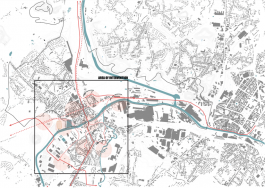Urban Stitching
Guenola Bayon de Noyer, Thomas Lauwers, Laura Pajaro
Urban Assemblages II
Marchienne-au-pont is a town full of history - one of the oldest in the territory of Charleroi. It has undergone processes of deindustrialisation and currently is perceived negatively from locals and people outside of the community. Demographically, Marchienne has a strong presence of Middle-East and North African communities, as well with Belgians and Italians nationals.
The burden added by the negative image brought by the media to the already weighty strain of industrial decay keeps dragging back the city. The urban landscape epitomises the deterioration of economic activities and reinforces the fixed idea of a scarcely livable town. Only under the shadow of Charleroi’s modernisation, the municipality has regained strength to build a brighter future. Nevertheless, it is by the hand of their own citizens in collaboration with policy-makers Marchienne-au-pont will set stereotypes aside.
With powerful traditions and folkloric dynamics, Marchienne remains a city pierced by a dominant industrial landscape and contaminated fruitless soil. The abandoned lots give evidence of the population fleeing from the town. Regardless, it wasn’t until the 1980s that the city experienced the tragedy of unemployment and decline.
The following project proposal aims to continue with the narrative of the master plan of Charleroi. It points to reconcile the inherited industrial landscape of Marchienne-au-Pont with the new developments through a mix of public space and infrastructure for private investment. We intend to reinforce social relations in the city and promote public encounters.
For this end, we showcase three key scenarios that we consider should be developed in parallel of Charleroi Master Plan. Each of them contains different urban typologies, mobility plan and considers private investment on different scales. In the end, we hope to create multiple axes of interventions along with the city that connects with Charleroi and other municipalities.
The development of these distinct scenarios takes into account different temporalities and the actors who participate. We defined these areas following a field study. This process allowed us to highlight perceptions of the infrastructure and figure whether these are general symptoms of other issues regarding individual perception of the space or they are the real cause of the illness.
Our goal is to interpret these results while considering variables such as density, particularities of the landscape and communities living in there. We hope to consolidate scalable typologies that address the identity of the city.
Urban Stitching
Guenola Bayon de Noyer, Thomas Lauwers, Laura Pajaro
Urban Assemblages II


Marchienne-au-pont is a town full of history - one of the oldest in the territory of Charleroi. It has undergone processes of deindustrialisation and currently is perceived negatively from locals and people outside of the community. Demographically, Marchienne has a strong presence of Middle-East and North African communities, as well with Belgians and Italians nationals.
The burden added by the negative image brought by the media to the already weighty strain of industrial decay keeps dragging back the city. The urban landscape epitomises the deterioration of economic activities and reinforces the fixed idea of a scarcely livable town. Only under the shadow of Charleroi’s modernisation, the municipality has regained strength to build a brighter future. Nevertheless, it is by the hand of their own citizens in collaboration with policy-makers Marchienne-au-pont will set stereotypes aside.
With powerful traditions and folkloric dynamics, Marchienne remains a city pierced by a dominant industrial landscape and contaminated fruitless soil. The abandoned lots give evidence of the population fleeing from the town. Regardless, it wasn’t until the 1980s that the city experienced the tragedy of unemployment and decline.
The following project proposal aims to continue with the narrative of the master plan of Charleroi. It points to reconcile the inherited industrial landscape of Marchienne-au-Pont with the new developments through a mix of public space and infrastructure for private investment. We intend to reinforce social relations in the city and promote public encounters.
For this end, we showcase three key scenarios that we consider should be developed in parallel of Charleroi Master Plan. Each of them contains different urban typologies, mobility plan and considers private investment on different scales. In the end, we hope to create multiple axes of interventions along with the city that connects with Charleroi and other municipalities.
The development of these distinct scenarios takes into account different temporalities and the actors who participate. We defined these areas following a field study. This process allowed us to highlight perceptions of the infrastructure and figure whether these are general symptoms of other issues regarding individual perception of the space or they are the real cause of the illness.
Our goal is to interpret these results while considering variables such as density, particularities of the landscape and communities living in there. We hope to consolidate scalable typologies that address the identity of the city.